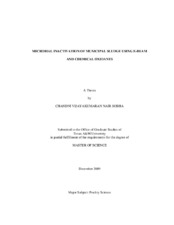| dc.description.abstract | Municipal biosolids generated from waste water treatment plants should be
effectively disinfected before being used for beneficial purposes. Novel sewage sludge
treatment technologies ensuring efficient microbial inactivation and sludge stabilization
can help in reducing adverse environmental and health impacts. The underlying
hypothesis of this study was that electron beam irradiation solely, or in combination with
chemical oxidants such as ferrate or chlorine dioxide, will effectively inactivate the
microbial loads in municipal biosolids. The specific objectives of the research were to
determine the inactivation of selected microbial pathogens and indicator
organisms(Salmonella Typhimurium, Escherichia coli, phi X 174, MS2, poliovirus,
Bacillus subtilis and Clostridium perfringens spores) using high energy (10 MeV) ebeam
irradiation in the presence and absence of ferrate and or chlorine dioxide.
Additionally, a quantitative microbial risk assessment (QMRA) exercise was performed
to evaluate the risk reduction using e-beam technology.
Results indicated that susceptibility of different target organisms to the e-beam
irradiation varied considerably, with bacteria being most sensitive and bacterial
endospores being most resistant in both aerobically and anaerobically treated sludge.
Bacteria as well as poliovirus were susceptible to 200 ppm of ferrate. However,
coliphages and endospores could be inactivated, only when ferrate was combined with ebeam.
Somatic coliphage were susceptible 30 ppm of chlorine dioxide treatment, where
as poliovirus and endospores were resistant to 30 ppm chlorine dioxide treatment.
Microbial inactivation by e-beam and chemical oxidants depended upon the sludge
matrix (aerobic and anaerobic).QMRA results indicate that the application of e-beam
technology to sludge applied to lettuce growing field reduced the risk of food borne
outbreaks to below detectable level. Overall, the results highlight the efficiency and
stability of e-beam and chemical oxidants in ensuring sludge disinfection and safe
nutrient recycling. | en |


